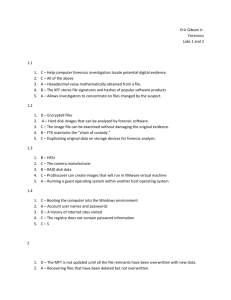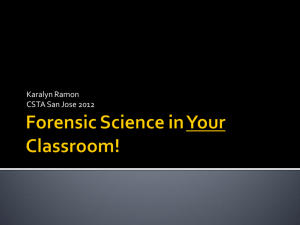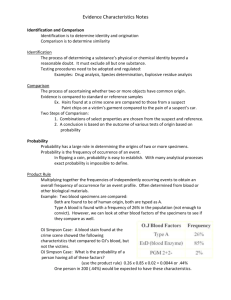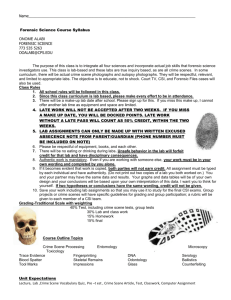Computer Fraud and Abuse
advertisement
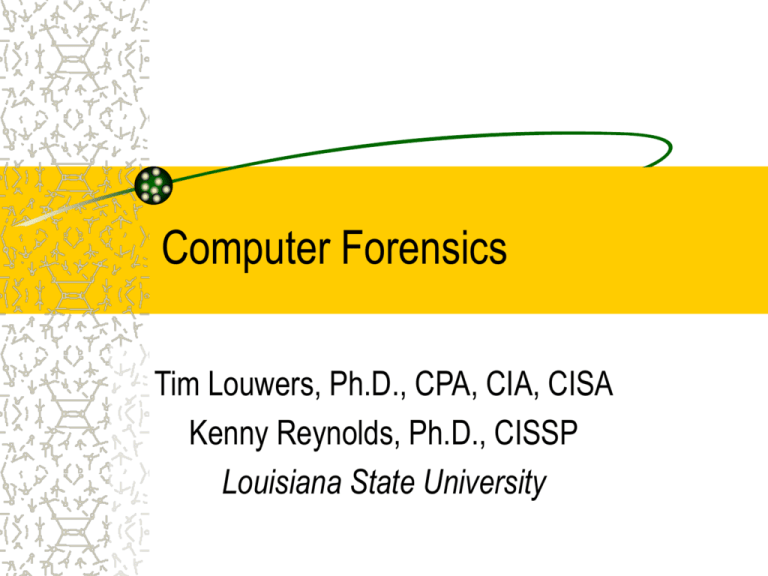
Computer Forensics Tim Louwers, Ph.D., CPA, CIA, CISA Kenny Reynolds, Ph.D., CISSP Louisiana State University Computer Crime Types of Computer Crimes – Hacking/cracking, network intrusion – Computer virii – Harassment and cyberstalking – Industrial espionage, insider crimes – Employee misconduct – Child porn – Pirated software Basically, any crime that is aided or abetted by a computer 2 Examples Hackers reroute phone lines to guarantee winning radio giveaway. – Two Porsches and $30,000 Network Program Designer unleashes $10 million computer “bomb.” – Bomb permanently deleted all of the company’s sophisticated software programs. Three Drexel frat brothers “fix” horse race – Prosecutors called it a real-life version of "The Sting" -- an insider exploiting a hole in computer security to create a surething horse racing bet worth more than $3 million. 3 Computer Forensics Defined “The employment of a set of predefined procedures to thoroughly examine a computer system using software and tools to extract and preserve evidence of criminal activity.” --The SANS (SysAdmin, Audit, Network, Security) Institute “The application of computer investigation and analysis techniques in the interests of determining potential legal evidence." -- Judd Robbins (Computer Forensics Investigator) “The science of acquiring, preserving, retrieving, and presenting data that has been processed electronically and stored on computer media.” – The Federal Bureau of Investigation 4 Computer Forensics Computer is used as a storage media -evidence can be retrieved even when the data is deleted. Useful aid in law enforcement. – Tracking terrorists – Impeaching Presidents – Tracing computer virus creators Potential deterrent to computer criminals? 5 Evidence that can be found with Computer Forensic Techniques All existing data in the computer's directory structure. Any deleted files which have not yet been overwritten by the operating system. Deleted emails. Pages recently printed on the suspect's printer. Renamed files. Application software. Specific words, numbers, etc. Recently accessed web sites. Passwords to commonly used programs/websites. Password protected files. 6 I. Search and Seizure: 4th Amendment: "Reasonable Expectation of Privacy" A search is constitutional if it does not violate a person's "reasonable" or "legitimate" expectation of privacy. “Closed container” rule – The Fourth Amendment generally prohibits law enforcement from accessing and viewing information stored in a computer without a warrant if it would be prohibited from opening a “closed container” (e.g., briefcase or file cabinet) and examining its contents in the same situation. 7 I. Search and Seizure: Intelligence Gathering Is there a computer in use? What kind of computer and operating system? What evidence do you want? How sophisticated is the suspect? 8 I. Search and Seizure: The Raid • Control the scene • Time the raid so that you have control. • Control individuals • Separate suspects from the equipment. • Control others present even if they are not suspects. • Identify potential evidence • Know what you are looking for. • Eliminate threats • Assess the possibility that the system can be controlled from a remote system... • Eliminate this threat immediately!!! 9 II. Processing the Scene CRIME SCENE CRIME SCENE CRIME SCENE 10 II. Processing the Scene (Continued) Document! Document!! Document!!! – The individual who occupies the office – The name of the employees that may have access to the office – The location of the computer system in the room – The state of the system (whether it is powered on, and what is visible on the screen) – The people present at the time of the raid – The serial number, models, and makes of the hard drives and components of the system – The peripherals attached to the systems 11 II. Processing the Scene (Continued) On-screen activity -- Power down or not? Is the activity destructive? – Yes -- Stops/Freezes further data loss if selfdestructing software in use Is there anything of evidentiary value? – No -- You will lose anything that’s in memory – Verify system info (date and time) – Capture process listings and open files 12 II. Processing the Scene (Continued) Wear surgical gloves Photograph – Books – Papers – Notes – Hardware Note position of all manuals Seize all manuals Sketch entire PC, including connections 13 II. Processing the Scene (Continued) Tag and label all physical components and record identifying information. Clearly label components with a "DON'T TOUCH OR OPERATE" warning! Only disassemble enough to facilitate transport. Pack and pad components in boxes with static resistant packing. 14 II. Processing the Scene (Continued) Identify Network connections (LAN, WAN, DSL, Cable) and disable. Tag both ends of all wires, even if one end of the wire is not connected to anything! Be aware of wireless networks. Disconnect phone and modem lines. – Mark each line so you know where it came from. – Do NOT unplug power for memory phones, fax machines, modems, caller ID boxes. 15 III. Preserving the Evidence Typical kinds of evidence in computer forensics – Computer log files • Successful and failed logins, website hits, access logs, error logs, etc. – Other access records • Phone records, physical access logs – E-mail communications – Electronic storage media • Hard drive, floppy disks, CDs, tapes, other media – Hardcopy records 16 III. Preserving the Evidence Evidence Life Cycle: – – – – – Collection and Identification Analysis Storage, Preservation, Transportation Presentation Return (if applicable) Thou shall not alter the evidence in any way. Ensure that: – No evidence is damaged, destroyed, or otherwise compromised. – Evidence is properly handled and protected – Information which must remain private does so: • Any client-attorney information that is inadvertently acquired • Information which would require a warrant must have one 17 III. Preserving the Evidence: Protecting data on the hard drive DON’T BOOT FROM THE HARD DRIVE – Boot from other media: • Boot from floppy or CD – Use new boot disks for each seizure – Access hard drive as slave in another machine – Use write-protecting software or device The only reason you will use the suspect hard drive: – To create an image of it. 18 III. Preserving the Evidence (Continued) Make a mirror image backup of the hard drive – Digital evidence can be duplicated with no degradation from copy to copy. – Authenticate the file system Seal and safeguard the originals and work with disk images 19 III. Preserving the Evidence: Examples of Imaging Tools HARDWARE SOFTWARE Tape Drives Removable Media (Zip, Jaz, etc.) Clone or Slave Drives Network Servers Optical Drives (CD-ROM, Magneto-Optical, DVD, Etc.) Disk Duplicators Byte Back Linux "dd" Norton Ghost SafeBack EnCase SnapBack DatArrest Anadisk/Teledisk Image Idiskdup 20 III. Preserving the Evidence: Examples of Imaging Tools (continued) EnCase (Guidance Software, Pasadena, CA) – Imaging program -- makes an exact image of the original hard drive. – Provides authentication of the file system – “THE” standard commercial computer forensic toolkit. Norton Ghost 21 III. Preserving the Evidence: Chain of Custody Chain of Custody – Who obtained it? – When / where was it obtained? – Who secured it and how? – Who controlled it after being secured? – Who accessed or handled it? – Fewer custodians is better – less to testify Evidence Tag 22 IV. Evidence Examination Use a systematic approach – Create an examination log – Keep detailed notes – Audio tape your examination Admissibility: – Must be relevant, reliable, permissible – Hearsay Rule 23 IV. Evidence Examination: Finding the needle … Discovering all files – including normal files, deleted yet remaining files, hidden files, password-protected files, and encrypted files. Recovering all (or as much as possible) of deleted files. Revealing the content of hidden files as well as temporary files – ones used in both the application programs and the operating system. Accessing the contents of protected and encrypted files – only if possible and legally appropriate. 24 IV. Evidence Examination: Finding the needle (continued) Analyze all possibly relevant data – items found in special and typically inaccessible areas of the disk – Unallocated space on a disk – currently used, but possibly the repository of previous data that is relevant evidence – Slack space in a file – the remnant area at the end of a file in the last assigned disk cluster, that is unused by current file data, but once again maybe a possible site for previously created and relevant evidence Print out an overall analysis of the subject computer system, as well as a listing of all possible relevant files and discovered data files 25 IV. Evidence Examination: Finding the needle: Deleted files Often, evidence that the suspect no longer believes is recoverable can be found on the suspect’s computer. File “Delete” does not necessarily remove the file itself An investigator can use the complete or incomplete portions of “deleted” files to obtain valuable evidence or leads in a case 26 IV. Evidence Examination: Deleted File Recovery Tools Software – Norton Un-erase – EnCase Hardware – Raw Disk Readers 27 EnCase 28 Summary Computer crime is more than hacking Just because it’s deleted doesn’t mean it’s gone Don’t touch that computer! DO NOT ACCESS FILES! – Make copies -- examine copied files Document EVERYTHING! Maintain chain of custody 29 Acknowledgements We would like to thank the following for their assistance in the preparation of this presentation: – LSU students and alumni • Patrick Blake, Erin Hopper, Jackson Kon, Eric Smith, Xiaotao Wang – LSU’s Computer Forensic Lab 30 Computer Forensics Resources Federal Guidelines for Search and Seizing Computers http://www.usdoj.gov/criminal/cybercrime/search_docs/toc.htm FBI Handbook of Forensic Services http://www.fbi.gov/hq/lab/handbook/intro.htm Updates and Supplementary DOJ Information http://www.usdoj.gov/criminal/cybercrime/searching.html Computer Crimes Criminal Justice Links http://www.co.pinellas.fl.us/bcc/juscoord/ecomputer.htm Computer and Internet Security Links http://www.virtuallibrarian.com/legal/ Forensics Science and Law Enforcement Links http://www.ssc.msu.edu/~forensic/links.html The National White Collar Crime Center PC Forensics http://www.pcforensics.com Computer Forensics, Inc. www.forensics.com SC Magazine www.scmagazine.com 31


